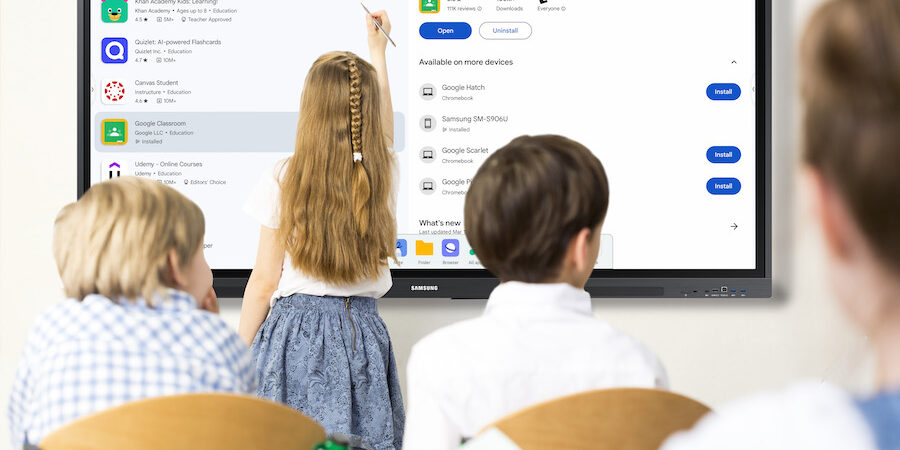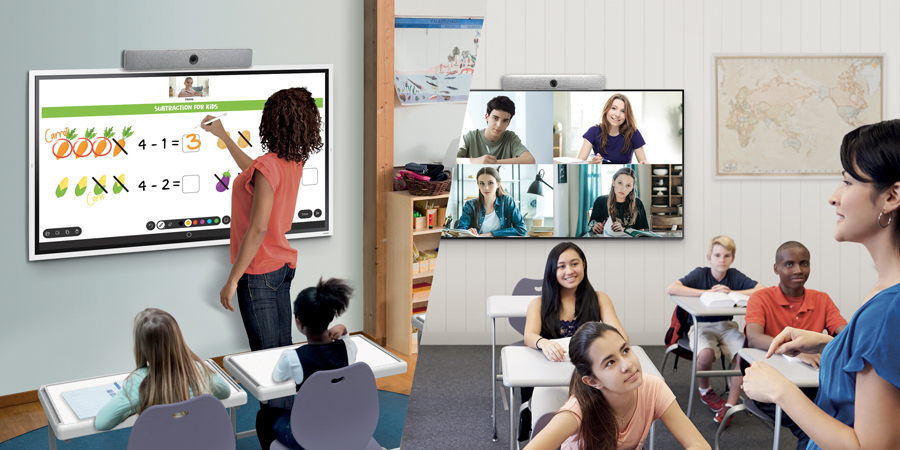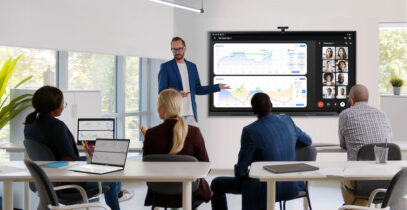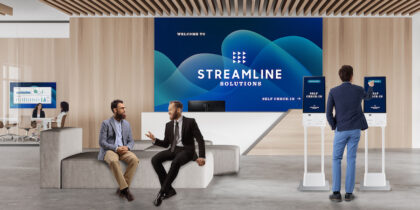There’s never been a better time to create a connected digital classroom. With emerging technologies like artificial intelligence (AI) driving rapid innovation across industries, students need to learn how to manage digital tools for the classroom and interact with digital learning environments. Indeed, 92% of today’s jobs already require digital skills, according to a 2023 report from the National Skills Coalition — and that number will only continue to grow as today’s K-12 students progress toward graduation.
Interactive displays are critical to any connected classroom ecosystem, helping teachers deliver digital lesson plans and keeping students engaged. A stronger ecosystem also improves education outcomes by connecting ideas, concepts, materials — and students — more effectively.
While classroom digital whiteboards have been around for a while, newer interactive displays like the EDLA-certified Samsung WAD Interactive Display give teachers even more tools to connect the classroom than ever before.
What is a connected classroom?
A connected classroom allows educators and students to engage with content and interact in a supportive, collaborative space, using education tech tools to their advantage. As new technologies emerge, those connection points continue to expand and grow.
Blended learning without limits
Simple, scalable and secure display solutions empower educators to take control of curriculum. Download Now
There are various technologies within a successful connected digital classroom. In addition to interactive displays, a connected digital classroom requires input devices such as laptops, desktops, tablets and smartphones. All these devices can support collaboration in real time with anyone in a classroom or remote setting, as well as interact with a wide range of media, curricula, files and web content.
Software plays an important role, too. For example, Samsung DeX allows educators to extend their smartphones or tablets to the interactive whiteboard, so they can move throughout the classroom and maintain control of the board. By connecting a tablet or smartphone to a Samsung WAD Interactive Display using DeX, teachers can create a powerful classroom experience that strengthens and expands the ecosystem. Educators can use the display as a webcam, microphone — which both can be toggled on or off — document scanner, and presentation tool while also using educational apps in the Android Play Store. Students can also cast their devices onto an interactive display, making collaboration a regular part of the school day.
Reaching every student
The ability of every student to participate in the classroom is one of the critical benefits of having a digital ecosystem. Students and educators gain tremendous value from a digitally enabled classroom.
Every learning style is supported
The connected classroom meets students wherever they are. Technology — especially smart boards — can be used as assistive classroom components. The expanded suite of tools allows teachers to customize and personalize lessons to align with individual learning styles, both in the presentation of material and the practice of skills in teamwork exercises.
That’s particularly useful to the more than 7 million K-12 students in the U.S. with physical and learning disabilities, such as autism and ADHD. Using a smart interactive whiteboard to display additional multimedia can remove obstacles for students with learning challenges who require additional support. Students with differing fine motor skills can leverage the interactive display by writing with their fingers or a tennis ball. English language learners, who make up more than 10% of public school students, can benefit, too, for example, through translation apps and software the boards can access.
Teachers aren’t tied to the front of the classroom
A connected classroom lets teachers move seamlessly between devices and screens, whether sitting at their desks or standing in the back of the classroom. Hogg New Tech Center, an elementary school in Dallas, Texas, uses interactive whiteboards from Samsung to make it easier for teachers to incorporate technology into their daily classwork — without needing to set anything up or manually connect to a device or projector.
Increased support for remote and hybrid learning
A connected classroom allows teachers to reach students who are not physically in the classroom and engage with classmates who are. This means a campus music teacher can notify the classroom via the display, for example, even if they aren’t in the building. The display also makes it easier to share classroom materials with students everywhere.
Limitless access to educational experiences and resources
Teachers can use a classroom digital whiteboard, such as the Samsung WAD Interactive Display, to connect to the internet, bringing audio, applications, video and other web content directly to students. Educators can integrate this content with the existing curriculum, elevating the experience. The more seamless the casting, broadcasting, and sharing, the better the learning experience. The Android operating system also makes doing this easier, as it’s already familiar to many.
Security to oversee all connected devices
Robust device management tools enable you to oversee all connected devices on your school’s network. These solutions, such as Samsung device management and mobility software, monitor device health. They allow IT teams to troubleshoot issues remotely, track usage, filter content, configure devices, and deploy software updates and security controls — so you can rest assured your connected classroom is always protected.
Get started with implementing digital ecosystems
Samsung WAD interactive displays are ideal, as they work with most devices and boast several connectivity options. Nevertheless, choosing the display that best fits your technology needs and education goals is important, so start by identifying and defining these clearly. Also, assess your current situation:
- What technology do you already have? Is it functional?
- Can you elevate its use by adding key investments, such as interactive displays or tablets?
- Do you have your own information technology team, or will you need to partner with a strong technology solutions provider?
Funding comes next. The Federal Communications Commission is providing cash to help schools upgrade their connectivity. The E-rate program provides up to $4.456 billion for schools that qualify. In addition, the U.S. Department of Education has several grant programs to help schools fund digital learning, and state and local education agencies may have grant monies available to fund education tech initiatives at local K-12 schools. Corporate and nonprofit organizations and educational foundations can also be great funding sources.
A vibrant ecosystem
Creating a successful connected ecosystem starts with incorporating digital tools for the classroom that are easy to use and powerful, such as Samsung WAD displays. They enable students to achieve higher levels of cognitive retention, leading to more empowered learners.
Learn more about how an interactive display can transform the classroom and elevate learning. Also, consult this free planning resource for innovative ideas for the connected classroom.








